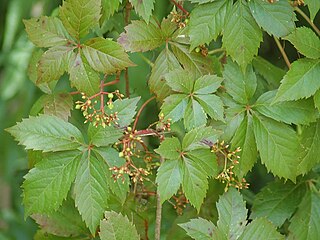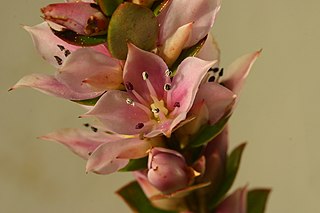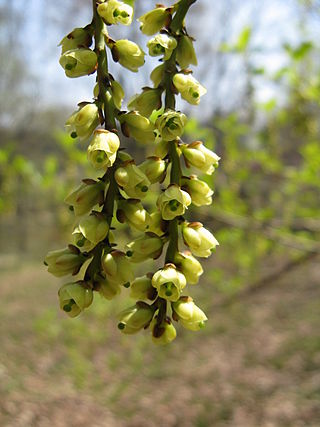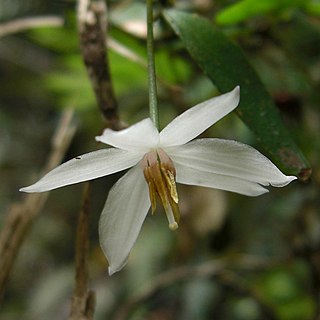
Asterales is an order of dicotyledonous flowering plants that includes the large family Asteraceae known for composite flowers made of florets, and ten families related to the Asteraceae. While asterids in general are characterized by fused petals, composite flowers consisting of many florets create the false appearance of separate petals.

Flowering plants are plants that bear flowers and fruits, and form the clade Angiospermae, commonly called angiosperms. They include all forbs, grasses and grass-like plants, a vast majority of broad-leaved trees, shrubs and vines, and most aquatic plants. The term "angiosperm" is derived from the Greek words ἀγγεῖον / angeion and σπέρμα / sperma ('seed'), meaning that the seeds are enclosed within a fruit. They are by far the most diverse group of land plants with 64 orders, 416 families, approximately 13,000 known genera and 300,000 known species. Angiosperms were formerly called Magnoliophyta.

A vine is any plant with a growth habit of trailing or scandent stems, lianas, or runners. The word vine can also refer to such stems or runners themselves, for instance, when used in wicker work.

Toxicodendron is a genus of flowering plants in the sumac family, Anacardiaceae. It contains trees, shrubs and woody vines, including poison ivy, poison oak, and the lacquer tree. All members of the genus produce the skin-irritating oil urushiol, which can cause a severe allergic reaction. The generic name is derived from the Greek words τοξικός (toxikos), meaning "poison," and δένδρον (dendron), meaning "tree". The best known members of the genus in North America are poison ivy (T. radicans), practically ubiquitous throughout most of eastern North America, and western poison oak, similarly ubiquitous throughout much of the western part of the continent.

Toxicodendron radicans, commonly known as eastern poison ivy or poison ivy, is an allergenic flowering plant that occurs in Asia and eastern North America. The species is well known for causing urushiol-induced contact dermatitis, an itchy, irritating, and sometimes painful rash, in most people who touch it. The rash is caused by urushiol, a clear liquid compound in the plant's sap. The species is variable in its appearance and habit, and despite its common name, it is not a true ivy (Hedera), but rather a member of the cashew and pistachio family (Anacardiaceae). T. radicans is commonly eaten by many animals and the seeds are consumed by birds, but poison ivy is most often thought of as an unwelcome weed. It is a different species from western poison ivy, T. rydbergii, which has similar effects.

Campsis radicans, the trumpet vine, yellow trumpet vine, or trumpet creeper, is a species of flowering plant in the trumpet vine family Bignoniaceae, native to eastern North America, and naturalized elsewhere. Growing to 10 metres, it is a vigorous, deciduous woody vine, notable for its showy trumpet-shaped flowers. It inhabits woodlands and riverbanks, and is also a popular garden plant.

The cherry blossom, or sakura, is the flower of trees in Prunus subgenus Cerasus. "Sakura" usually refers to flowers of ornamental cherry trees, such as cultivars of Prunus serrulata, not trees grown for their fruit. Cherry blossoms have been described as having a vanilla-like smell, which is mainly attributed to coumarin.

Campsis, commonly known as trumpet creeper or trumpet vine, is a genus of flowering plants in the family Bignoniaceae, native to woodlands in China and North America. It consists of two species, both of which are vigorous deciduous perennial climbers, clinging by aerial roots, and producing large trumpet-shaped flowers in the summer. They are reasonably hardy and do well with the support of a wall, preferring full sun.

Echinops is a genus of about 120 species of flowering plants in the family Asteraceae, commonly known as globe thistles. They have spiny foliage and produce blue or white spherical flower heads. They are native to Europe, east to central Asia, and south to the mountains of tropical Africa. Globe thistle is the host plant of weevil Larinus vulpes.

Parthenocissus quinquefolia, known as Virginia creeper, Victoria creeper, five-leaved ivy, or five-finger, is a species of flowering vine in the grape family, Vitaceae. It is native to eastern and central North America, from southeastern Canada and the eastern United States west to Manitoba and Utah, and south to eastern Mexico and Guatemala.

Prunus serrulata or Japanese cherry is a species of cherry tree that grows naturally in Japan, China, Korea, and Vietnam, and it also refers to a cultivar produced from Prunus speciosa, a cherry tree endemic in Japan. Historically, the Japanese have developed many cultivars by selective breeding of cherry trees, which are produced by the complicated crossing of several wild species, and they are used for ornamental purposes all over the world. Of these, the cultivars produced by complex interspecific hybrids based on the Oshima cherry are also known as the Cerasus Sato-zakura Group.

The rosids are members of a large clade of flowering plants, containing about 70,000 species, more than a quarter of all angiosperms.

Sarcococca is a genus of 11 species of flowering plants in the box family Buxaceae, native to eastern and southeastern Asia and the Himalayas. They are slow-growing, monoecious, evergreen shrubs 1–2 m (3–7 ft) tall. The leaves are borne alternately, 3–12 cm long and 1–4 cm broad.

A flower, also known as a bloom or blossom, is the reproductive structure found in flowering plants. Flowers consist of a combination of vegetative organs – sepals that enclose and protect the developing flower, petals that attract pollinators, and reproductive organs that produce gametophytes, which in flowering plants produce gametes. The male gametophytes, which produce sperm, are enclosed within pollen grains produced in the anthers. The female gametophytes are contained within the ovules produced in the carpels.

Euonymus fortunei, the spindle, Fortune's spindle, winter creeper or wintercreeper, is a species of flowering plant in the family Celastraceae, native to east Asia, including China, Korea, the Philippines and Japan. E. fortunei is highly invasive and damaging in the United States, causing the death of trees and forest in urban areas.

Geissoloma is a genus of flowering plants in the monotypic family Geissolomataceae, native to the Cape Province of South Africa. Geissoloma marginatum is the only species in the family. It is sometimes called guyalone in English. The plants are xerophytic evergreen shrubs and are known to accumulate aluminum.

Stachyurus is the only genus in the flowering plant family Stachyuraceae, native to the Himalayas and eastern Asia. They are deciduous shrubs or small trees with pendent racemes of 4-petalled flowers which appear on the bare branches before the leaves. The plants have leaves with serrate margins.
Klaus Kubitzki was a German botanist. He was Emeritus professor in the University of Hamburg, at the Herbarium Hamburgense. He is known for his work on the systematics and biogeography of the angiosperms, particularly those of the Neotropics, and also the floristic record of the Tertiary era. His plant systematic work is referred to as the Kubitzki system. He was a member of the American Society of Plant Taxonomists.

Luzuriaga radicans is a species of flowering plant in the genus Luzuriaga of the family Alstroemeriaceae (Inca-lilies), part of the monocot order Liliales. It is native to Chile and Argentina.

Scirpus radicans is a species of flowering plant belonging to the family Cyperaceae.


















